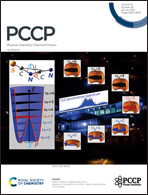Mixture of an ionic liquid and organic solvent at graphene: interface structure and ORR mechanism
Abstract
Aprotic lithium–oxygen batteries are attracting the attention of the scientific community due to their outstanding theoretical performance, which, however, still has not been achieved in practice. One of the promising directions for improving the stability of Li–O2 batteries is electrolyte design, which would provide good cyclability, inhibition of parasitic processes, and high energy density. In recent years, there has been progress in the use of ionic liquids in the composition of the electrolyte. The present work reveals possible explanations of the influence of the ionic liquid on the mechanism of the oxygen reduction reaction by the example of a combined electrolyte from an organic solvent DME and an ionic liquid Pyr14TFSI. Molecular dynamics modelling of the interface between a graphene electrode and an organic solvent DME with a variable volume fraction of the ionic liquid shows the influence of the electrolyte structure at the interface to the kinetics on the adsorption and desorption stages of oxygen reduction reaction reactants. The obtained results suggest the promotion of a two-electron oxygen reduction reaction mechanism through the formation of solvated O22−, which may explain the reduced recharge overpotential reported in experiments.



 Please wait while we load your content...
Please wait while we load your content...